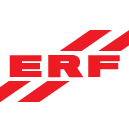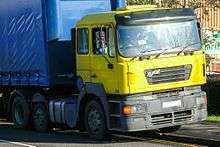ERF (truck manufacturer)
 | |
| Industry | Automotive |
|---|---|
| Fate | Closed |
| Successor | MAN |
| Founded | 1933 |
| Founder | Edwin Richard Foden |
| Defunct | 2007 |
| Headquarters | Middlewich, England |
| Products |
Trucks Buses |
| Parent | MAN |
| Website | www.erf.com |
ERF was a British truck manufacturer. It was stablished in 1933 by Edwin Richard Foden from whoms initials the company was named. Iits factory in Middlewich closed in 2002, and it was discontinued as a marque by owner MAN in 2007.
History
_tractor_unit%2C_2012_HCVS_Tyne-Tees_Run.jpg)

.jpg)
In 1881 the first Foden traction engine was built in Sandbach. Then in 1898 Edwin Richard Foden influenced future truck design by designing the first steam wagon running on steel tyre wheels which had been successful until 1913 when vulcanised solid rubber tyre development had advanced to the stage of allowing their fitment on heavy vehicles. Edwin introduced the first pneumatic-tyred Foden steam wagon, but as steam transport appeared to be going out of favour, Edwin turned his attention to the development of a 6-8 ton chassis fitted with new Gardner LW (Light Weight) high speed oil-engine.
At the beginning of the 1930s, Britain's industry was struggling to survive the worst recession in living memory and unemployment exceeded two million. At this time insurers were becoming increasingly reluctant to underwrite steam boilers. As a result, Edwin believed the future of the lorry building industry lay in diesel engine power. The Foden boardroom did not agree, and consequently he resigned along with his son Dennis.
With the help of his son Dennis and two former colleagues, including Ernest Sherratt who became Chief Engineer, Edwin worked to build the first ERF diesel lorry in 1933 and gave the first chassis the number 63 which was Edwin's age. From the beginning the company only bought components from other suppliers rather than manufacture itself, including engines from Gardner, gearboxes from David Brown and axles from Kirkstall Forge Engineering. This concept would serve ERF well throughout its existence. A new and striking cab was styled by Sandbach coachbuilder John Henry Jennings, who also provided initial factory space to assemble the new lorry. Based in Sandbach, the company made its own chassis and cabs, originally with engines from Gardner, but later also Cummins, Rolls Royce, Perkins, Detroit Diesel and Caterpillar.[1]
ERFs used to be marketed under the Western Star badge in some countries such as Australia.[2] It also built a specialist fire engine chassis, with a body built on by in-house company JH Jennings, later Cheshire Fire Engineering. However, when recession came in the early 1980s and production fell from a total output of 4,000 chassis per annum, CFE was sold to management to eventually become Saxon Sanbec.
ERF was never a major manufacturer; as an example their domestic sales total only reached 1,083 trucks in 1981.[3] The company was bought by Canadian truck maker Western Star in 1996.[4] However, after Paccar's purchase of Foden, DAF Trucks and Leyland Trucks competitive pressure increased, and after Western Star was approached by Freightliner Trucks, the decision was made to sell ERF.
Purchase by MAN
In March 2000, ERF became part of MAN with production moving to a new factory in Middlewich[5]. It was later discovered that fraud had occurred at ERF and its financial position had been incorrectly stated with MAN winning a legal case against Freightliner.[6][7] Freightliner in turn tried to sue Western Star and ERF's former auditors Ernst & Young, but failed on the grounds of corporate negligence.[8]
Final model range
ERF's final model range consisted of the ECT, ECM and ECL built on MAN's production line in Munich (for heavy trucks), and a plant in Middlewich for light trucks - positioned to win a contract from the Ministry of Defence for 8,000 new British Armed Forces trucks.
All the ERF trucks were based on MAN's existing products, the only difference being that the ERF model came with the option of specifying use of Cummins ISMe power plant as an alternate to MAN's own D20 common rail power-plant. The Middlewich factory closed in 2002, with production of the ECT moved to Munich, Germany, ECM and ECL units moved to Steyr, Austria where they are built on the same facilities as their identical MAN counterparts.[1][9]
In the light of Cummins' intransigence on upgrading the ISMe engine to comply with the Euro4 emission regulations, MAN initially decided to replace it completely with the new series of MAN D20 engines.[10] With ERF badging only used for the British market, MAN decided to cease supplying ERF badged trucks from July 2007 onwards.[4][11]
In popular culture
- On the BBC motoring programme Top Gear, the presenters are challenged to buy lorries and presenter Richard Hammond buys an ERF from Walker Movements Limited in Leicester. He pronounces the name phonetically. In response to a quip about its diminutive size, Hammond responds by calling it 'the Caterham of lorries' as it has an engine that could match Jeremy Clarkson's 12 litres (732.3 cu in) Renault Magnum, but as light and as small as James May's Scania P94D. It was also the fastest among the three; it has a top speed that exceeds 90 miles per hour (145 km/h).
References
- 1 2 History ERF Historic Vehicles
- ↑ Truck Reflections: Back to Before Fully Loaded 15 January 2018
- ↑ Kennett, Pat, ed. (May 1982). "Truckchat". TRUCK. London, UK: FF Publishing Ltd: 8.
- 1 2 How ERF made is marque Commercial Motor 24 January 2008
- ↑ MAN snaps up ERF Commercial Motor 3 February 2000
- ↑ MAN suspends ERF management The Daily Telegraph 17 December 2001
- ↑ MAN beats Freightliner in High Court Commercial Motor 3 November 2005
- ↑ E&Y heads off £350m Freightliner claim Accountancy Age 11 September 2007
- ↑ ERF ends tractor building in UK Commercial Motor 7 March 2002
- ↑ Big Lorry Blog : Friday, 2 December 2005 - Posts Archived 27 September 2007 at the Wayback Machine.
- ↑ MAN ends ERF production Commercial Motor 26 July 2007
Bibliography
External links
| Wikimedia Commons has media related to ERF vehicles. |